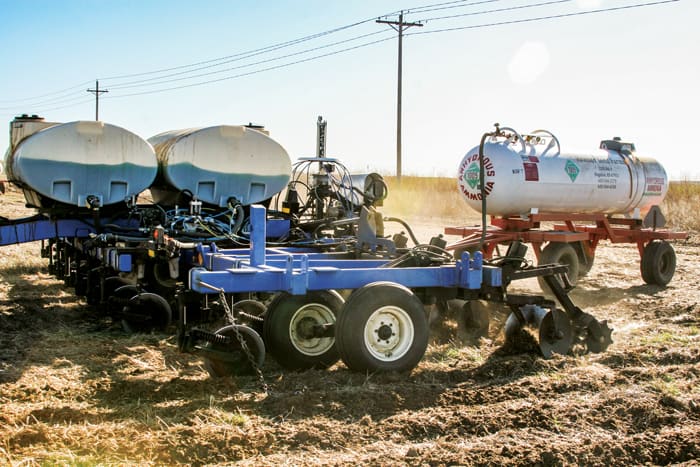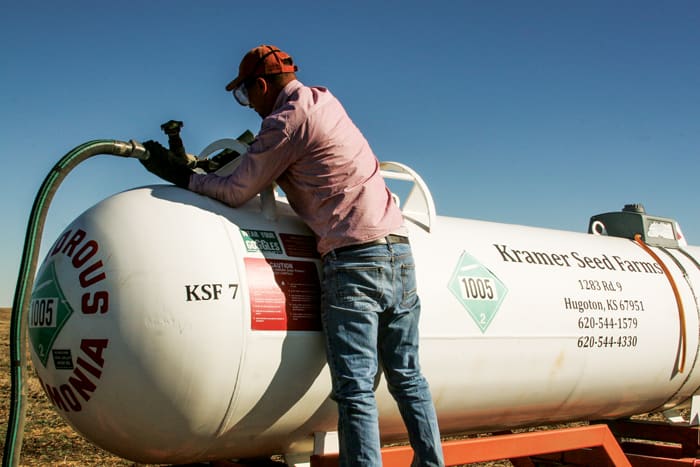Ben McClure was a recent ag economics graduate from Kansas State University when he went to work for Kramer Seed Farms in southwestern Kansas near Hugoton in 2003. His arrival came just as the multigenerational family farm was about to embark on a series of changes that has radically altered its farming operation, and significantly boosted its financial well-being.
“That was the beginning of a long period of cultural change on the farm that is still rippling through the operation,” he says. “It was a time when diesel fuel was very expensive and we were looking for ways to save trips across the field and cut expenses and labor,” Before my time, everything was farmed conventionally, usually with 3-4 tillage passes each year ahead of the planter.”
Quitting the Plow
By 2005 the operation had purchased a 30-foot DMI 2510 strip-till rig equipped with coulters, shanks and closing disks followed by a berm builder on the back. They ran that rig and moved to all liquid fertilizer for several years, and realized significant savings in fuel and labor expenses.
The farm had been grid sampled in 1998 and at the time of the switch to strip-till, McClure says the operation was moving into zone sampling and investing in more precise nutrient monitoring.
Strip-Till Nitrogen Comparison
Treatment 1 – Strip-till – all dry
- Urea and 11-52-0
- All fertilizer placed with strip-till
Treatment 2 – Strip-till – dual placement
- NH3 and 10-34-0
- 2/3 placed with strip-till
- 1/3 placed with sidedress
- No N-Serve or nitrogen stabilizer
Treatment 3 – Strip-till – Exactrix
- NH3, 10-34-0, 12-0-0-26S
- All placed at strip-till
Treatment 4 – Strip-till – All liquid
- 2/3 N placed with strip-till
- 1/3 fertigated
After 4 nitrogen treatments were repeated on three separate areas of Kramer Seed Farms, manager Ben McClure says use of an Exactrix system proved to be the most economical with a savings of up to $67 per acre of N.
“We were also using variable-rate fertility with Raven and Tee-Jet systems, and were moving into variable-rate seeding with our planters,” he added.
What he didn’t realize at that time was the move to strip-till had set the farm up for an even steeper climb up the economic-efficiency ladder through then-emerging fertilizer technology.
Today, a managing partner in the 3,500-acre cash-rent, predominately irrigated operation, McClure says a typical year’s production includes about two-thirds of the acreage in corn with some cotton, grain sorghum or sunflowers included, and about one third of the land in winter wheat planted behind corn.
The wheat acres also include certified seed production for AgriPro Seed Wheat Associates and LIMAgrain Cereal Seeds — which adds value to the wheat crop.
Fertilizer Efficiency
Strip-tilled corn yields average 220 bushels per acre and can jump to 250 in “good-weather” years. But McClure says the money-maker today comes from the fact he and his crew are saving about $30-$70 per acre on nitrogen (N) and phosphorus (P) with the efficiency found in their Exactrix fertilizer system.
The system includes a high-pressure (300 psi) anhydrous ammonia injector that delivers NH3 to the ground as a liquid. It also features a formulator which injects liquid P (potassium thiosulfate) and liquid sulfur (ammonium thiosulfate) simultaneously with the NH3.
The “collision” of the 3 formulations causes a distinctive chemical reaction and crystalline formation of TAPPS (triammonium polyphosphate sulfate).
Exactrix founder Guy Swanson says the TAPPS concept provides a stable form of the three nutrients directly below the crop for improved nutrient uptake and crop performance. Tests show the system allows N recommendations from 0.6-0.8 of conventional soil lab rates based on application timing.

BUSY TOOL. Pre-Plant nitrogen (N), phosphorus (P) and sulfur are blown into soil slots behind the DMI strip-tiller by Exactrix engines mounted on the trailing coulter bar. The system combines high-pressure anhydrous ammonia with liquid potassium (K) and liquid sulfur to form a stable, highly-available crystalline nutrient source for Kramer Seed Farm’s irrigated crops. (Photo Courtesy of Exactrix Global Systems)
In 2010, Kramer Seeds Farms invested in the system, seeking improvements in fertilizer placement and efficiency.
“We added a 30-foot, 15-inch coulter bar to the DMI strip-tiller and equipped it with a modified mole knife from Shield Ag which allows the dual-injection of potassium and sulfur,” McClure says. “The anhydrous injection nozzle is mounted adjacent to the mole knife.
“All of that is now operated by our John Deere controller and display since we consolidated everything three years ago and removed lots of clutter from the cab.”
Double-Digit Savings
Since adopting the Exactrix system, McClure has tested and retested the it against 3 other nutrient management recipes and, even with drastically reduced N application rates, he has seen no drop in corn yields.
After 4 nitrogen treatments were repeated on three separate areas of Kramer Seed Farms, manager Ben McClure says the economics of total operating expenses per acre of corn production were as follows:
- Treatment 1 — $696.67 per acre.
- Treatment 2 — $674.64 per acre.
- Treatment 3 — $634.84 per acre.
- Treatment 4 — $701.94 per acre.
“These tests showed us we’re saving between $27 and $67 per acre on N inputs with the Exactrix system,” McClure says. “Farming 2,500 acres of corn, that can mean the difference in $67,500 to $167,500 to cover depreciation, interest on fixed costs and profits.”

“When I can take the fertilizer budget and cut it in half, that’s a lot of money…” — Ben McClure
An ag economist at heart, McClure says even with the lower return of $27 per acre on 2,500 acres of corn production, the savings amount to what a producer would spend for the least expensive Exactrix system. “The second year, you can keep that bonus,” he explains.
Currently, McClure says Kramer Seed Farm is producing high-yield corn on about 140-148 pounds of N per acre applied with the system. The same 15-inch coulter system is used to sidedress wheat in the snow and to fertilize sunflower stands in the spring.
“I know strip-till has saved us a lot of time and fuel on the tractors, but the real economic boost came from the way we operate today and the fertilizer savings we’re realizing,” he says. “I try to budget 12% of our gross operating expenses on fertility, and talking with various bankers in our area I understand other growers are spending 20-25% for fertilizer.

CHEAP & EFFICIENT. Anhydrous ammonia is the primary nitrogen (N) source at Kramer Seed Farms. As the least expensive form of N available, it is a primary ingredient in the a application strategy which can provide ample N for crops at significantly lower rates than traditional lab analysis recommendations. (Photo Courtesy of Exactrix Global Systems)
“When I can take the fertilizer budget and cut it in half, that’s a lot of money. I don’t know how we could have stayed in business without it.”
Residue Management
Although he is a believer in reduced tillage, McClure says the large quantities of corn residue behind high-yield crops, some years even after running cattle on the stalks, can blow into piles and windrows, which makes planting difficult.
“These tests showed us we’re saving between $27 and $67 per-acre on N inputs…”
“That’s why we generally do a very light vertical tillage with a tandem disk Landoll ahead of strip-tilling,” he says. “The stalks stand through the bulk of the winter to catch snow and after we pull the cows off around April 1, we till a couple inches deep to break stalks and get some dirt on the residue.”
After strip-tilling and applying TAPPS, McClure says he likes to get a watering on the field, although sometimes planting with their 12-row Deere 1720 planter comes the day after strip-tilling. The planter runs Sunco trash whippers and a stock Deere row unit equipped with Precision Planting’s eSet seeding spacing and depth control system.
“Most of our hybrids come from Phillips Seed Farms, and we mainly try to use 113-114 day maturity corn,” he says. “Some places we plant 108-109 day hybrids to save ourselves a couple of passes with the sprinkler at the end of the season, and to get the field back in wheat quicker.”
No-till wheat is custom planted by McClure’s brother, who uses a Deere 1890 CCS drill equipped with Exactrix Wing Injection.
“It’s not cheap, but savings on fertilizer is more than enough to pay for the custom planting,” he explains. “Yields run 75-80 bushels per acre on average, and 100-bushel yields are not out of the question in a good year. But, as with the corn, the extra margins we have because of fertilizer savings goes along way.”







